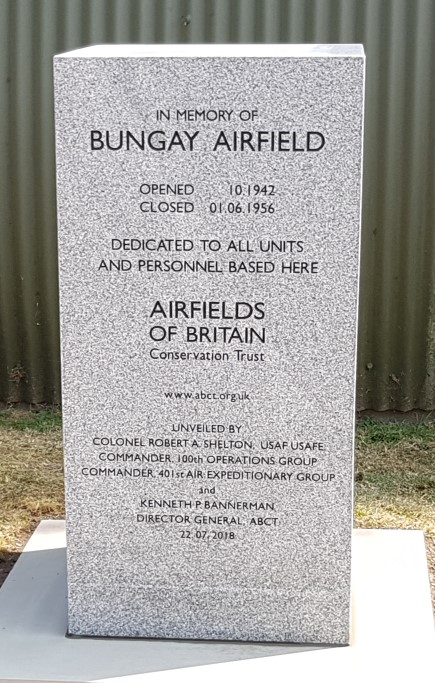Bungay Airfield Monument
Details:
To the left beside the 446th Bomb Group propeller monument.
An upright, rectangular, stone block containing a commemoration message that is inscribed in English in incised lettering. The monument dedicated to the Bungay Airfield (also known as HMS Europa II / RAF Bungay / RNAS Bungay and USAAF Station 125), was unveiled on the 22nd July 2018 by Kenneth P Bannerman, Director General of the Airfields of Britain Conservation Trust who had arranged for this memorial to be placed here and by Colonel Robert A Shelton, USAF USAFE, Commanding Officer of the 100th Operations Group and 401st Air Expeditionary Group.
Royal Air Force Bungay or more simply RAF Bungay (known locally as Flixton) is a former Royal Air Force station. Bungay airfield was originally planned as a satellite for nearby RAF Hardwick and was constructed by Kirk & Kirk Ltd., during 1942 with the main runway of 6,000 feet in length and two intersecting secondary runways, one of 4,220 feet and the other of 4,200 feet. In common with other airfields of the period, the technical, administrative, and domestic buildings were dispersed to lessen the impact of any enemy air attack. The buildings were all of a temporary nature and the various sites were chiefly to the west of the airfield.
Additional construction was performed at Bungay until November 1943 when the airfield received the Eighth Air Force 446th Bombardment Group (Heavy) from Lowry AAF, Colorado. The 446th was assigned to the 20th Combat Bombardment Wing and the group tail code was a "Circle-H". Its operational squadrons were:
- 704th Bombardment Squadron (FL)
- 705th Bombardment Squadron (HN)
- 706th Bombardment Squadron (RT)
- 707th Bombardment Squadron (JU)
The 446th operated chiefly against strategic objectives on the Continent from December 1943 until April 1945. Targets included U-boat installations at Kiel, the port at Bremen, a chemical plant at Ludwigshafen, ball-bearing works at Berlin, aero-engine plants at Rostock, aircraft factories at Munich, marshaling yards at Coblenz, motor works at Ulm, and oil refineries at Hamburg.
Besides strategic missions, the group often carried out support and interdictory operations. It supported the Normandy landings in June 1944 by attacking strong points, bridges, airfields, transportation, and other targets in France. It aided ground forces at Caen and Saint-Lô during July by hitting bridges, gun batteries, and enemy troops. Dropped supplies to Allied troops near Nijmegen during the airborne attack on the Netherlands in September. Bombed marshaling yards, bridges, and road junctions during the Battle of the Bulge, December 1944 - January 1945. Dropped supplies to airborne and ground troops near Wesel during the Allied assault across the Rhine in March 1945.
The 446th Bomb Group flew its last combat mission on 25 April, attacking a bridge near Salzburg. It returned to Sioux Falls AAF, South Dakota, during June and July 1945, being inactivated there on 18 August 1945.
The airfield was sold in 1962.
Source of information: www.warmemorialsonline.org.uk, en.wikipedia.org, www.aviationmuseum.net
Source of images: www.aviationmuseum.net
Monument Text:
IN MEMORY OF
BUNGAY AIRFIELD
|
OPENED CLOSED |
10.1942 01.06.1956 |
DEDICATED TO ALL UNITS
AND PERSONNEL BASED HERE
AIRFIELDS
OF BRITAIN
Conservation Trust
www.abct.org.uk
UNVEILED BY
COLONEL ROBERT A. SHELTON, USAF USAFE
COMMANDER, 100th OPERATIONS GROUP
COMMANDER, 401st AIR EXPEDITIONARY GROUP
and
KENNETH BANNERMAN
DIRECTOR GENERAL ABCT
22 07, 2048
Commemorates:
Units:
329th Bomber Squadron, 93rd Bomber Group, Heavy
428th Bomber Squadron, 310th Bomber Group
446th Bomb Group
704th Bomber Squadron, 446th Bomb Group, Heavy
705th Bomber Squadron, 446th Bomber Group, Heavy
706th Bomber Squadron, 446th Bomb Group
707th Bomber Squadron, 446th Bomb Group
8th Air Force
US Army Air Corps
Wars:
WWII

